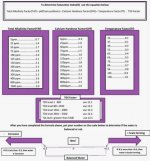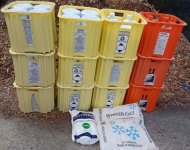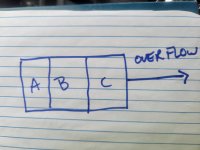Are you ever successful in balancing the Calcium Saturation Index without having to adjust the alkalinity and/or calcium saturation by a large amount?
With that as a background, my question is one of how well you are managing your CSI index between summer and winter conditions.
There's probably no factual answer to this question, only anecdotal happenstance for each one of us, but I still am curious if anyone is more successful than I am at arriving at a balance that isn't constantly changing in terms of how I need to adjust the alkalinity and/or calcium saturation levels.
In California, during the summer my water is about 70 to 85 degrees most of the time where there is evaporation which causes me to have to add high alkalinity (180 ppm) and low calcium (180 ppm) well water to top off the pool to the skimmer levels; in winter the water is around 40 to 55 degrees most of the time where the monsoon rains cause high acid zero alkalinity (0 ppm TA) and zero calcium (0 ppm CH) to be added to the uncovered pool (to the point it overflows out the drainage holes).
I don't chase the pH other than to use HASA muriatic acid to lower the well-water-fill alkalinity to around 100 ppm, and I don't modify the CYA as I use HASA liquid chlorine at a level at least 7.5% of the FC level given my summer CYA is about 30 ppm (winter CYA drops to around 20 ppm due to the rain dilution combined with me getting lazy since the sun is at a lower angle and the daylight hours are lower and temps are lower so the CYA isn't as critical to manage).
What's singular about California is there is always literally zero rain from about early March to about early December, and then we have the unpredictable rainy season - where it can be a drought - in which case we have almost no rain - or - we have sporadic monsoons from about December to March - so there are really two seasons in terms of water that is added, the summer being predictable at no water, and the winter being unpredictable at from low water to monsoon levels.
I'm well aware the factors that go into the CSI calculation, which, mostly are temperature and pH and carbonate alkalinity, but also to a lesser extent CH, CYA, TDS, and borate levels, where, for me, in terms of summer and winter fluctuations, the two factors most affecting my CSI seem to be
Of course I'm aware there is an AGGRESSIVE:OK:GREAT:OK:SCALING range, with there being a wide "OK" range on either side of GREAT, which means we don't have to be at exactly a 0.0 CSI, but still - I'm finding, essentially, the following:
Also luckily, I'm happier to be on the positive CSI range (scaling) than the negative (aggressive) for my plaster pool, especially as I don't have SWCG equipment.
Even luckier, I guess, is that many people just ignore CSI and concentrate only on chasing ranges (not me, but I understand many people do that).
The reason for this question is simply to learn how others handle the different CSI conditions between summer and winter, as outlined above.
In the end, I'm doing ok, but I could be doing better in terms of finding a happy medium of calcium hardness & carbonate alkalinity between summer and winter.
How about you?

<----- aggressive ------ 0 ------ scaling ------>
I'm doing ok... but I could be doing better (in terms of managing my CSI between summer & winter).- The water temperature fluctuates wildly between summer and winter of course
- Its pH remains generally on the high end of the pH ceiling (around 7.8 or 7.9), and there aren't any water features to gas off the CO2
- The Total Alkalinity is adjusted with muriatic acid to about 100 ppm in general
- I adjust Calcium hardness to somewhere around 3 times the TA, in general, using Snow Joe pellets
- CYA is kept low on purpose, at around 30 ppm, to keep the FC needs lower
- TDS is around 500 ppm (extremely low bather load and it's not a SWCG pool)
- Borates/Phosphates/Iron/all-that-other-stuff is 0
- Free Chlorine is always kept at least 7.5% of the CYA level
- Combined Chlorine is generally less than 0.5 ppm
- The pool is in-ground, plaster, with a tile waterline, no heater, no cover, no shade
With that as a background, my question is one of how well you are managing your CSI index between summer and winter conditions.
There's probably no factual answer to this question, only anecdotal happenstance for each one of us, but I still am curious if anyone is more successful than I am at arriving at a balance that isn't constantly changing in terms of how I need to adjust the alkalinity and/or calcium saturation levels.
In California, during the summer my water is about 70 to 85 degrees most of the time where there is evaporation which causes me to have to add high alkalinity (180 ppm) and low calcium (180 ppm) well water to top off the pool to the skimmer levels; in winter the water is around 40 to 55 degrees most of the time where the monsoon rains cause high acid zero alkalinity (0 ppm TA) and zero calcium (0 ppm CH) to be added to the uncovered pool (to the point it overflows out the drainage holes).
I don't chase the pH other than to use HASA muriatic acid to lower the well-water-fill alkalinity to around 100 ppm, and I don't modify the CYA as I use HASA liquid chlorine at a level at least 7.5% of the FC level given my summer CYA is about 30 ppm (winter CYA drops to around 20 ppm due to the rain dilution combined with me getting lazy since the sun is at a lower angle and the daylight hours are lower and temps are lower so the CYA isn't as critical to manage).
What's singular about California is there is always literally zero rain from about early March to about early December, and then we have the unpredictable rainy season - where it can be a drought - in which case we have almost no rain - or - we have sporadic monsoons from about December to March - so there are really two seasons in terms of water that is added, the summer being predictable at no water, and the winter being unpredictable at from low water to monsoon levels.
- Summer = 180 ppm TA & 180 ppm CH well water
- Winter = 0 ppm TA & 0 ppm heavy rain water (or not)
I'm well aware the factors that go into the CSI calculation, which, mostly are temperature and pH and carbonate alkalinity, but also to a lesser extent CH, CYA, TDS, and borate levels, where, for me, in terms of summer and winter fluctuations, the two factors most affecting my CSI seem to be
- Temperature
- Diluent (either well water or rain water, depending on the season)
Of course I'm aware there is an AGGRESSIVE:OK:GREAT:OK:SCALING range, with there being a wide "OK" range on either side of GREAT, which means we don't have to be at exactly a 0.0 CSI, but still - I'm finding, essentially, the following:
- Summer = I have to lower the calcium levels to get closer to a 0 CSI
- Winter = I have to raise the calcium levels to get closer to a 0 CSI
Also luckily, I'm happier to be on the positive CSI range (scaling) than the negative (aggressive) for my plaster pool, especially as I don't have SWCG equipment.
Even luckier, I guess, is that many people just ignore CSI and concentrate only on chasing ranges (not me, but I understand many people do that).
The reason for this question is simply to learn how others handle the different CSI conditions between summer and winter, as outlined above.
In the end, I'm doing ok, but I could be doing better in terms of finding a happy medium of calcium hardness & carbonate alkalinity between summer and winter.
How about you?


Last edited:



